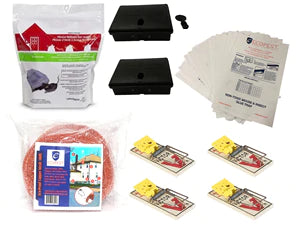You love and care for animals. You also want a home that is rodent-free. But this does not have to come at the expense of wildlife or the environment. Neither should your pets be put at risk.
The most effective and humane way to solve rodent problems is prevention. Why? Prevention minimizes the use of rodenticides. These poisons cause rodents to suffer slow and painful deaths and risk the lives of predators like owls which feed on them. Other animals like squirrels, birds and even your pets can eat poisoned bait by mistake and suffer the same slow and painful death.
Prevention tackles the root problem and makes your home less attractive to rodents. You break the cycle of temporary fixes and returning unwelcomed guests.

How can you prevent rodents from moving in and cause trouble at home? Try these four simple steps:
Step one – Remove attractants
Rodents are drawn to areas with abundant food and shelter (i.e. places to fill up and chill!). Make your home less attractive to mice and rats by removing as many of these as possible.
Around the exterior of buildings, remove items that are stacked close to the building foundations. Trim and thin out plantings, remove debris and consider eliminating some plants. Don’t provide convenient hiding spots close to your house!
In your yard, laneway, carport or balcony, secure garbage and compost, keep people and pet food indoors, and clean up any fallen fruit or spilled bird seed. This will help ensure you don’t accidentally feed rodents and uninvited wildlife.
If rodents have already entered your home, minimize attractants inside. Keep food inside glass, metal or plastic containers, in secure drawers or cupboards, or in the fridge. Pet food can be a buffet for rodents so rethink where and how to feed your furry family members. Store food waste in secure bins or the freezer until it is time for your green waste pick up.
Step two – Locate entry points
Take a walk around the exterior of your home and examine your balcony if in an apartment. Scan up to the roofline as rodents are excellent climbers. Can you see any gaps, open vents, or other potential points of access? Remember, mice can enter a home through holes as small as a dime!
Next, examine the interior of your home searching for where rodents might enter. Pull out large appliances from the wall, move boxes and furniture out from walls and open cupboards. Carefully examine where pipes or wires come through drywall as this is a common point of entry. Look for holes, rodent droppings (small rice size is a mouse, almond size is a rat), and any signs of gnawed wood, wire or insulation. You may need a flashlight.
Step three – Exclude and repair
To rodent-proof, you will need to close off all the points of access that you identified. Use rodent exclusion materials like heavy-gauge wire screening to cover holes, metal mesh to stuff into holes around pipes, and expanding foam sealant to spray overtop of metal mesh and fill other gaps and cracks. Seal all potential entry holes or gaps in walls, foundations, sheds, crawl spaces and under porches. If needed, consider installing door sweeps to remove access through spaces underneath doors. Use vent covers where needed.
If the work is extensive and involves lots of ladder climbing, it may be best to hire a rodent-proofing professional. You can find AnimalKind companies recommended by the BC SPCA here.
Step four – Maintain, maintain, maintain!
Rodents have large, strong front teeth built for gnawing that can chew through almost anything (including metal!). That’s why the last step in keeping your home rodent-proofed is to regularly check for signs of renewed rodent activity and make repairs promptly.





